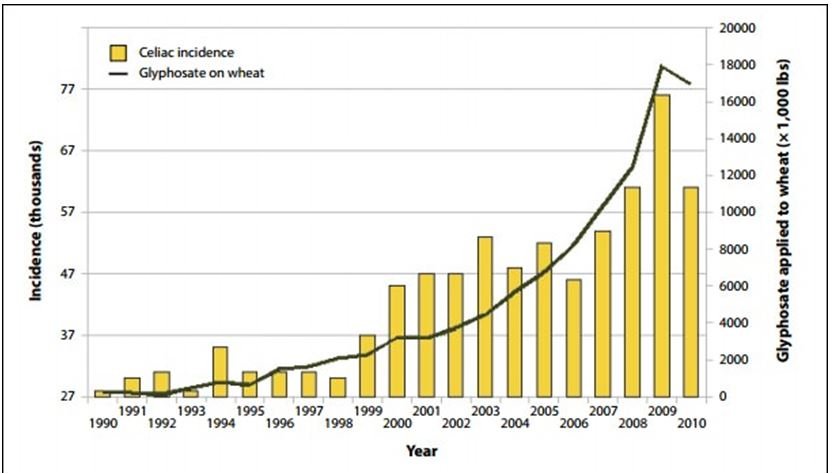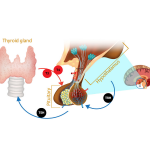Glyphosate: Effects on Health
Humaira Quraishi, ND, MS
Docere
Who would ever think we’d be consuming herbicide/pesticides in foods other than fruits, vegetables, and grains? Well, think again. Glyphosate, an herbicide contained in the popular product Roundup, and used to eradicate unwanted vegetation, has shown up in one of America’s favorite ice cream brands – Ben & Jerry’s.1
Glyphosate works by inhibiting the enzyme EPSPS (enolpyruvylshikimate-3-phosphate), which normally converts carbohydrates into essential metabolites such as amino acids, hormones, vitamins, etc.1 This inhibition leads to a deficiency within the plant, resulting in plant death. The use of glyphosate has increased exponentially, thanks to genetic engineering. It is used in over 750 different products, not only in agriculture, but also in home appliances.2 Organic Consumers Association found glyphosate in 10 of 11 samples of Ben & Jerry’s ice creams.3 Even though the levels were below the toxic threshold set by the Environmental Protection Agency (EPA), one can’t help but wonder how much we can ingest daily without even knowing we are ingesting it.
Celiac Disease
Research has found a correlation between the incidence of celiac disease and glyphosate usage as it applies to wheat (Figure 1).4

(Source: Samsel et al, 2013.4 Figure courtesy of Nancy Swanson.)
Figure 1. Celiac Incidence vs Glyphosate in Wheat4
Figure 1: Rise in Celiac Disease in Correlation with Glyphosate3
Glyphosate may contribute to gut dysfunction and the development of celiac disease by inhibiting breakdown of proteins such as gluten.4 There is also evidence to suggest that the herbicide compromises commensal gut flora and, through various mechanisms, contributes to microvilli damage and nutrient malabsorption.4,5 These damaging effects of glyphosate should be taken into consideration when treating a patient, to prevent the development of dysbiosis and chronic disease.
Cancer
Several studies found an increased risk for non-Hodgkin’s lymphoma in individuals who were occupationally exposed to pesticides or herbicides, including glyphosate, in the United States, Canada, and Sweden6; testing for glyphosate, which was conducted through blood and urine, detected glyphosate at high levels in agricultural workers and showed a dose-dependent response.6 One study also found an increase in micronuclei, a blood marker for genotoxicity and chromosomal damage, in residents of communities where glyphosate was sprayed.6 Glyphosate exposure has also been shown in population-based studies to correlate with non-Hodgkin’s lymphoma.7-9
While human trials examining glyphosate toxicity and cancer are still limited, we should still take into consideration glyphosate’s effects on rats and mice and the possibility that some of these effects could be relevant for humans as well. Several studies have found renal tubule carcinoma, haemangiosarcoma, skin tumors, and pancreatic islet-cell adenoma in animals experimentally exposed to glyphosate.6
Endocrine Disruption & Malformations
Endocrine disruption by glyphosate has been found to occur at very low concentrations. Specifically, ex-vivo experiments found glyphosate can prevent normal androgen activity in human liver cells at a dose of 0.5 ppm, which is 800 times lower than the amount of glyphosate found in some animal feed in the United States.10 Another study, conducted in 2013, found low levels of glyphosate to mimic the effects of estrogen in human breast cancer cells in vitro.10 In the European Union (EU), the maximum level of glyphosate permitted in drinking water is 100 ng/L.11 In this study, estrogenic effects of glyphosate, when combined with genistein, were seen at 0.169 ng/L, which is below their allowed level.12 The maximum level of glyphosate permitted in US drinking water is 700 µg/L, 7000 times higher than EU standards.13
Malformations in embryos have been observed in rabbits and rats in both high and low maternally toxic doses.14 Another study, conducted in Argentina, where genetically-engineered, glyphosate-tolerant soybeans are grown, revealed birth defects in human populations exposed to the glyphosate-treated crop.13 The malformations in this human population were similar to the frog and chicken embryos that were exposed to glyphosate. The embryonic malformations observed in animals have been shown to result from glyphosate interference with the retinoic acid signaling pathway during the development of the central nervous system.15
Other Effects of Glyphosate
Professor Monika Kruger from Leipzig University has conducted research on glyphosate and found livestock to become ill due to animal feed containing the highest concentrations of glyphosate – especially in corn, soya, and rapeseed.16 Dr Kruger has also discovered glyphosate in meat and has postulated that glyphosate can pass the placental barrier to reach embryos, as well as accumulate in fat tissue.16 Professor Gilles-Eric Seralini, from Caen University in France, found that “rats fed a diet of GM maize, or exposed to glyphosate, for two years developed higher levels of cancer and died earlier than controls.”17
Glyphosate has been shown to disrupt the function of cytochrome P450 enzymes.5,17 These cellular enzymes are critical for the metabolism of chemicals in the body, such as medications and toxins, neurotransmitters, steroids, cholesterol, and bile acids.
Glyphosate has been shown, in either human studies or animal models, to also affect other functions of the body:
- Defective insulin receptor function18
- Cellular oxidative stress6
- Decreased vitamin and mineral absorption, as glyphosate is a chelator19
- Impaired neurotransmitter production4
Closing Comments
Complete avoidance of glyphosate is not possible due to the amount used in agriculture. We still don’t know much about glyphosate, and in the meantime other herbicides and insecticide runoffs have accumulated in the US water supply. Avoiding food and water is not the answer. To properly address glyphosate, we need to educate patients about methods to decrease exposure:
- Test glyphosate levels within the body via blood and urine testing
- Test levels in drinking water, which is also available as a laboratory test
- Implement the 4R protocol to heal the gut lining and promote beneficial bacterial growth
- Assist with detoxification, glutathione status, and proper sulfation to help metabolize glyphosate
- Encourage proper awareness and education of herbicide/pesticide and GMO crops
- Avoid GMO crops
- Promote consumption of organically grown fruits and vegetables, as well as grass-fed meats
- Properly wash produce before consuming
- Replace vitamins, minerals, and probiotics to counteract the chelating effect of glyphosate
References:
- Strom S. Traces of Controversial Herbicide Are Found in Ben & Jerry’s Ice Cream. July 25, 2017. New York Times Web site. https://www.nytimes.com/2017/07/25/dining/ben-and-jerrys-ice-cream-herbicide-glyphosate.html. Accessed: October 10, 2017.
- National Pesticide Information Center. Glyphosate: General Fact Sheet. Last reviewed 2015. NPIC Web site. http://npic.orst.edu/factsheets/glyphogen.html. Accessed October 10, 2017.
- Cummins R. Dirty Dairy: Why Consumers Need to Force Ben & Jerry’s to Go Organic. July 25, 2017. Organic Consumers Association. Available at: https://www.organicconsumers.org/essays/dirty-dairy-why-consumers-need-force-ben-and-jerrys-go-organic. Accessed October 11, 2017.
- Samsel A, Seneff S. Glyphosate, pathways to modern diseases II: Celiac sprue and gluten intolerance. Interdiscip Toxicol. 2013;6(4):159-184.
- Samsel A, Seneff S. Glyphosate’s Suppression of Cytochrome P450 Enzymes and Amino Acid Biosynthesis by the Gut Microbiome: Pathways to Modern Diseases. Entropy. 2013;15(4):1416-1463.
- Guytan KZ, Loomis D, Grosse Y, et al. Carcinogencity of tetrachlorvinphos, parathion, malathion, diazinon, and glyphosate. Lancet Oncol. 2015;16(5):490-491.
- Eriksson M, Hardell L, Cariberg M, Akerman M. Pesticide exposure as risk factor for non-Hodgkin lymphoma including histopathological subgroup analysis. Int J Cancer. 2008;123(7):1657-1663.
- McDuffie HH, Pahwa P, McLaughlin JR, et al. Non-Hodgkin’s lymphoma and specific pesticide exposures in men: cross-Canada study of pesticides and health. Cancer Epidemiol Biomarkers Prev. 2001;10(11):1155-1163.
- De Roos AJ, Zahm S, Cantor K. et al. Integrative assessment of multiple pesticides as risk factors for non-Hodgkin’s lymphoma among men. Occup Environ Med. 2003;60(9):e11.
- Gasnier C, Dumont C, Benachour N, et al. Glyphosate-based herbicides are toxic and endocrine disruptors in human cell lines. Toxicology. 2009;262(3):184-191.
- Glyphosate in Surface Water. Last updated April 17, 2015. Glyphosate Facts. Available at: http://www.glyphosate.eu/glyphosate-surface-water. Accessed October 11, 2017.
- Thongprakaisang S, Thiantanawat A, Rangkadilok N, et al. Glyphosate induces human breast cancer cells growth via estrogen receptors. Food Chem Toxicol. 2013;59:129-136.
- US Environmental Protection Agency. What are EPA’s drinking water regulations for glyphosate? Available at: https://safewater.zendesk.com/hc/en-us/articles/212076457-4-What-are-EPA-s-drinking-water-regulations-for-glyphosate-. Accessed October 11, 2017.
- Antoniou M, Habib ME, Howard CV, et al. Teratogenic Effects of Glyphosate-Based Herbicides: Divergence of Regulatory Decisions from Scientific Evidence. J Env Anal Toxicol. 2012;S4:006. Available at: http://earthopensource.org/wp-content/uploads/Antoniou-Teratogenic-Effects-of-Glyphosate-Based-Herbicides.pdf. Accessed October 10, 2017.
- Paganelli A, Gnazzo V, Acosta H, et al. Glyphosate-based herbicides produce teratogenic effects on vertebrates by impairing retinoic acid signaling. Chem Res Toxicol. 2010;23(10):1586-1595.
- Wasley A. Deformities, sickness & livestock deaths: the real cost of glyphosate & GM animal feed? November 28, 2013. The Ecologist. Available at: http://tinyurl.com/lsvaeku. Accessed October 10, 2017.
- Nebert DW, Russell DW. Clinical importance of the cytochromes P450. Lancet. 2002;360(9340):1155-1162.
- Samsel A, Seneff S. Glyphosate pathways to modern diseases V: Amino acid analogue of glycine in diverse proteins. J Biol Phys Chem. 2016;16:9-46. Available at: http://tinyurl.com/zlr8ewj. Accessed October 11, 2017.
- The Detox Project. Glyphosate binds vital nutrients. 2015-2017. Available at: https://detoxproject.org/glyphosate/glyphosate-chelating-agent/. Accessed October 10, 2017.
image Copyright: <a href=’https://www.123rf.com/profile_fotogigi85′>fotogigi85 / 123RF Stock Photo</a>
 Humaira Quraishi, ND, MS, graduated in 2017 from both the College of Naturopathic Medicine and Nutrition Institute at the University of Bridgeport. Currently, Dr Quraishi is practicing in New Jersey and focusing her practice on gastrointestinal, endocrine, and allergy disorders.
Humaira Quraishi, ND, MS, graduated in 2017 from both the College of Naturopathic Medicine and Nutrition Institute at the University of Bridgeport. Currently, Dr Quraishi is practicing in New Jersey and focusing her practice on gastrointestinal, endocrine, and allergy disorders.










